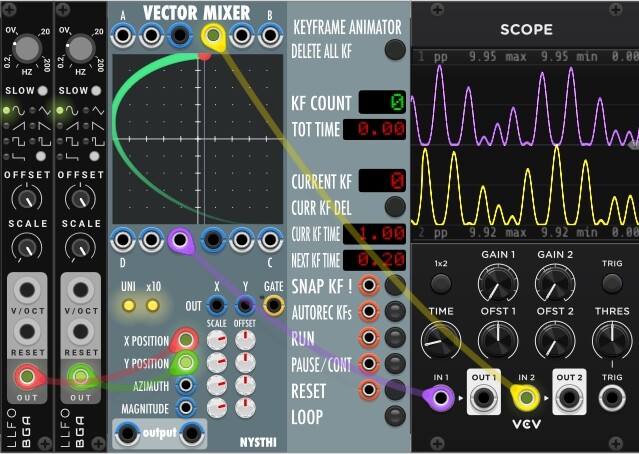Thank you very much, you touch on a lot of really great ideas: S&H, slew limiter, Bernoulli gate, flip/flop, edge detector, fixed voltage, offset, comparator and accumulator. The latter two can be combined. Resetting allows cycles/loops as well as counters.
@docB has a number of excellent (although sometimes deep) modules, and if you have the time, it for sure is valuable to look at some use cases, including many by the developer: docB at Patchstorage.
Another approach to keep things interesting seems to be the application of short-term generative and non-generative techniques to longer time frames, which sort of adds another meta level. I think of it as being like extending smaller circles into larger ones, as if constructing an epitrochoid.
For example, one could create a short melody sequence, let’s say with a note on every beat, so it is repeated in a relatively small circle for a while. To create the variation in the longer run, changing the melody’s key (and possibly scale) based on the note sequence would lend a structured, interlaced variation to the flow.
The timbre of a voice could be morphed or rotated round-robin style with each switch of the scale, perhaps on a slightly shorter or longer cycle.
Or you could use a Euclidian rhythm of e.g. 12 over 32 to repeatedly drive a percussion over e.g. two bars, and then take the same rhythm slowed down by 1/40th and thereby stretch out the pattern over 80 bars to rhythmically but infrequently trigger a slowly morphing sound or FX, or a one-shot sequence.
It probably is debatable whether mixing generative and deterministic elements invalidates a patch as being truly ‘generative’, but to me a lively semi-generative patch with a tiny bit of structure is preferable over a wild but repetitive purely generative piece.
There already is a number of good threads with tips for generative patches in this forum (selection below), and I want to explore further, which of these techniques could also be suitable for their use in the larger circles.
-
https://community.vcvrack.com/t/generative-techniques-skill-share-thread/930
-
https://community.vcvrack.com/t/what-constitutes-generative-behavior/1218
-
https://community.vcvrack.com/t/learning-self-generating-patch/4603
-
https://community.vcvrack.com/t/basic-workflows-for-ambient-generative-patches/5586
-
https://community.vcvrack.com/t/strip-preset-bird-realistic-generative-non-repetitive/12846
-
https://community.vcvrack.com/t/good-modules-for-generative/17293
-
https://community.vcvrack.com/t/generative-patch-morphing-between-two-sequences/19570
-
https://community.vcvrack.com/t/generative-processes-creative-intentionality/19656
-
https://community.vcvrack.com/t/how-to-make-interesting-generative-music-with-vcv-rack/20079
Finally, there probably also is quite a bit to learn from studying Krell patches:
-
https://community.vcvrack.com/t/lets-build-a-krell-patch-in-vcv-rack/2614
-
https://community.vcvrack.com/t/gretchenv-patches-experiments-and-releases/12458/35
-
https://community.vcvrack.com/t/welcome-to-mars-vcv2mars-1-minute-challenge/12519/13

